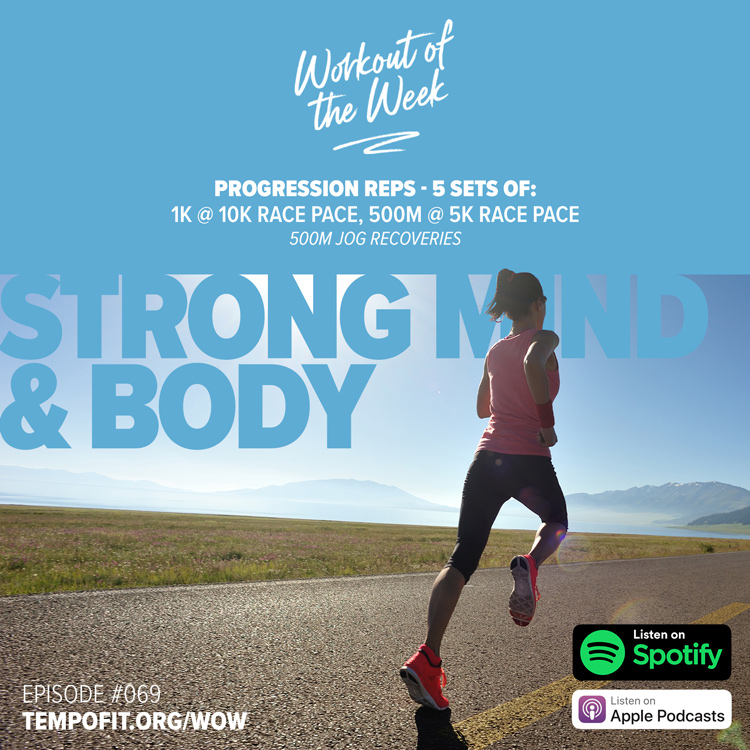
Welcome to a new block of training that I’m calling “Practice Makes Progress”. Over the next four weeks we’ll be doing progression-style workouts that focus on running faster as things get tougher. It’s great for the body and great for the mind!
WHAT?
5 sets of:
[1k @ your 10k race pace, 500m @ your 5k race pace, 500m jog]
Terrain: Running track or flat, measurable pathway.
Feels: Strong Mind & Body
Progression runs are perfect for building mental toughness to finish strong, even though things are heating up. They also make the body stronger by training good technique when fatigued and requiring more from the lungs and heart at the back end of efforts. When it gets tough, we get tougher!
WHY?
These sorts of workouts that incorporate progression elements into a traditional interval are designed to make you strong—in both body and mind.
Your lungs will get a good workout as you close each interval at 5k pace, which is starting to get toward that point where your oxygen uptake is working at max capacity. Your legs will also get a good workout due to both the length of this session (7.5k of faster work) and the faster 5k-speed segments.
Your mind will be tested particularly in the last few reps as you make that decision to accelerate for the final 500 even while fatigued.
HOW?
For most runners, your 5k speed will be between 7 and 13 seconds faster per kilometre than your 10k speed. So, as a rough rule of thumb, look to make your final 500m of each 1500m rep 5 seconds faster than the preceding two 500s. Use the Race & Pace Calculator on tempofit.org to predict your current 5k and 10k times.
Also, use those faster 500s to emphasise great technique. A focus on standing tall, stronger arm drive, quickened cadence, and good hip position, can sometimes be enough by itself to get you that extra 10 seconds per KM.
THOUGHT FOR THE WEEK:
WHAT IS SPEED? AND HOW DO I IMPROVE IT?
By Hayden Shearman
One of the best predictors of your marathon finish time is not your VO2max, but rather your all-out speed in a 200m sprint. This can sound counterintuitive for many runners as the marathon is supposed to be an endurance event not a speed-based event. But speed actually plays a very important role in setting a glass ceiling on your potential in longer distances.
So, what is speed and how do we improve it?
- Speed Isn’t Doing 1k Reps: The workout we’re doing this week (5x1500m at 10k to 5k race pace) is not technically a “speed” session. It’s primarily working on the metabolic and cardiovascular aspects of running, whereas speed will focus on the coordination and neural aspects of running fast.
- Hello, Fast Twitch Fibres: You’ve probably heard that everyone has different muscle fibre make ups. Some people are born with more fast twitch (i.e. great for sprinting) and others with more slow twitch muscle fibres (i.e. better for longer distances). This genetic ratio gives you your starting point, and while we can’t all have Usain Bolt’s muscle fibres, we can all improve by making the most of what we’ve got. But how?
- Run Fast and Often: Sprinting is much like the muscle memory that a pianist will build through doing scales. It’s repetition with great technique. If you don’t practice running fast, eventually you will lose the ability to do it. But if you make it a weekly or twice weekly thing, you’ll be reminding your body and brain of the neural pathways and movement patterns you want from it when working at 100% capacity.
- Run Fresh: This week’s workout teaches you to run faster when fatigued, which is great for building strength in body and mind, but it’s not great for building raw speed. For that, we want to be fresh with as little central nervous system fatigue as possible. So, for a speed session, you’d do just a light jog warm up with drills and dynamic stretches to make sure you’ve woken and warmed everything up. And between each rep you’ll be FULLY recovered in order to express max speed and recruit every muscle fibre possible.
- How A Speed Session Might Look: When you start doing faster running you will want to ease yourself into it. Your first ever session might be something like 4x 10 seconds at your mile pace. Next week will be 4×20 seconds, then 6x 20 seconds and 6x 30 seconds. After this first month you might increase the speed of these reps to 800m pace. After a couple of months of this you’ll look to increase the speed again and shorten the duration—something like 6x100m at 400m race pace. And eventually you’ll be doing true speed sessions like 6x 80m at max effort with 3-5 minute recoveries.So, for most runners, especially those over 30 who haven’t done much team sport or sprinting lately, it’s a journey that could take 3-4 months before it looks like a true “speed session”. But be patient and your hammies and achilles will appreciate the time to adapt!
- Other Sources of Speed: Sprinting isn’t the only way to improve speed; any fast, snappy action can help build speed (or at least builds athleticism which lays the foundation for speed to be trained). This could be high-speed skipping, low-resistance and high-RPM spinning on a bike, weight training with quick movements of the bar, plyometrics (jumping and bounding exercises), or team sports where you are accelerating and changing directions often. Like the sprinting progression above, you’ll want to slowly ease yourself into these other types of speed movements, as they all carry significant injury risks.
Got a training question? Email me!
Podcast (workout-of-the-week): Play in new window | Download
Subscribe: Apple Podcasts | RSS | More



